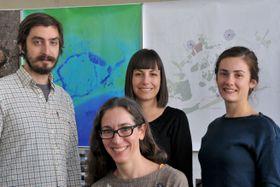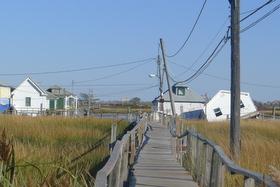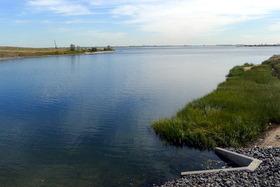
Professor Catherine Seavitt Nordenson (front) with members of her research team: (L to R) Eli Sands, Danae Alessi and Kjirsten Alexander

Some of the homes near Jamaica Bay that were damaged by Hurricane Sandy have yet to be repaired.

Creating a More Flood-Resistant Jamaica Bay
Professor Catherine Seavitt Nordenson awarded $250,000 to design strategies to improve coastal resiliency of a vital ecological resource
The City College of New York is one of four colleges and universities awarded grants from the Rockefeller Foundationto develop design strategies to improve resiliency in coastal zones subject to flooding such as that caused by Hurricane Sandy. The CCNY project will focus on developing proposals for Jamaica Bay, a 31-square mile estuarine embayment located in Brooklyn and Queens.
The research is intended to supplement the U.S. Army Corps of Engineers' North Atlantic Coast Comprehensive Study to examine risk reduction strategies for vulnerable coastal communities. Catherine Seavitt, associate professor of landscape architecture in City College's Spitzer School of Architecture, is the principal investigator on the grant.
In October 2012, Hurricane Sandy severely impacted Jamaica Bay and the surrounding land areas, including the Rockaway Peninsula, a barrier finger of land that forms the bay's southern boundary. While the area's natural wetlands and sandy beaches provided some resiliency to the brunt of the storm surge, urban development had compromised the region's protective capacity. Consequently, Jamaica Bay needs new management strategies to contain the loss of fragile marsh islands and nourish the sediment-starved bay.
"As sea levels rise and the risk of storm surge and flooding from hurricanes and other storms increases, the vast scale of Jamaica Bay allows this region of the city to be recast and restructured as an impactful ecological, infrastructural and community asset that can enhance the region's resiliency," said Professor Seavitt Nordenson, whose research focuses on design adaption to sea level rise in urban coastal environments and rethinking landscape restoration strategies to adapt to climate change.
Princeton University is coordinating the multi-university effort with a planning and engineering team. The City College grant, for $250,000 over 14 months, will be developed in three phases, each concluding with an interim review with peers from City College, other CUNY institutions, and invited guests.
In addition, Princeton will organize public workshops that will include representatives from the other institutions receiving grants – University of Pennsylvania, Harvard University and Princeton – and a panel of expert advisors.
At the end of each phase, the City College team will produce a report with a narrative and documentation of that phase's research, studies, analyses, maps and resilient design proposals. The final phase will conclude with the preparation of a final summary report and public exhibition.
In addition to Professor Seavitt Nordenson, the City College team consists of Kjirsten Alexander, MLA '12, senior research associate; Danae Alessi, MLA '13, research associate, and Eli Sands, a second-year landscape architecture graduate student, research assistant.
On the Internet
About The City College of New York
Since 1847, The City College of New York has provided low-cost, high-quality education for New Yorkers in a wide variety of disciplines. More than 16,000 students pursue undergraduate and graduate degrees in: the College of Liberal Arts and Sciences; the Bernard and Anne Spitzer School of Architecture; the School of Education; the Grove School of Engineering; the Sophie Davis School of Biomedical Education, and the Colin L. Powell School for Civic and Global Leadership. U.S. News, Princeton Review and Forbes all rank City College among the best colleges and universities in the United States.
MEDIA CONTACT
Ellis Simon
p: 212.650.6460
e:
esimon@ccny.cuny.edu